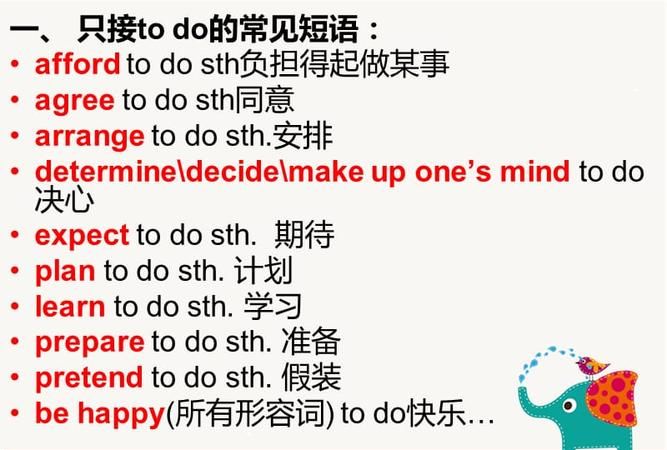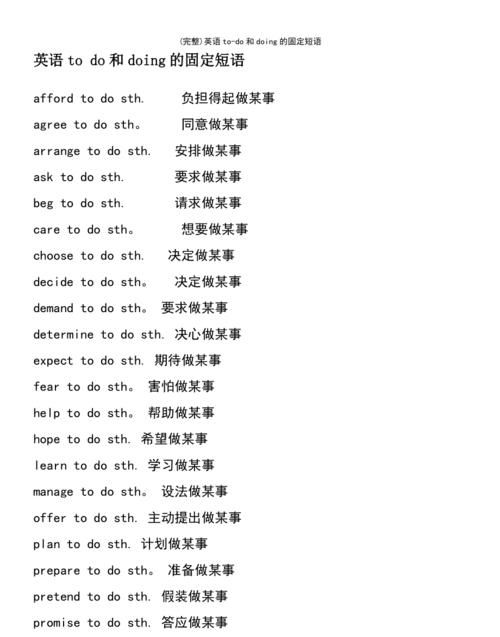本文目录
doing的用法
doing是非限制性的一种形式,动名词在句子中起名词的作用,如:Reading is important in learning English. 学英语,阅读是很重要的。 Looking after the patient is a nurse's job. 照顾病人是护士的工作。 动名词是由动词原形 + ing 构成,同现在分词形式一样,在句中可作主语, 宾语,表语和定语。 1) 动名词作主语: Talking like that is not polite. 那样谈话不礼貌。 Learning from others is important . 向别人学习很重要。 动名词可以象动词不定式一样,用 it 先行祠代替, 而把动名词写在后面。 It's no use waiting here, let's go home. 在这儿等着也没用,我们回家吧。 2) 动名词作表语 The nurse's job is looking after the patients. 护士的工作是护理病人。 Seeing is believing. 眼见为实。 3) 动名词作宾语 有些动词须用动名词来作宾语,它们是begin, mind, suggest, finish, stop, need, enjoy, miss, keep. Please stop smoking in the house. 请不要在家里抽烟。 I like reading in the forest. 我喜欢在树林里读书。 Do you mind my opening the windows? 你介意我打开窗户吗? 4)动名词作定语 She is studying in the reading room. 她在阅览室学习。 He slept in the sleeping bag. 他在睡袋里睡觉。

哪些动词后面跟to do和doing
suggest/finish/avoid/stop/can't help(禁不住) /mind (在乎) /need/enjoy/require/put off/delay/excuse/escape/miss 等动词都可以用动名词doing作宾语.

英语动词后跟doing的单词
下面是doing结构的句型:
1、 enjoy doing sth享受做某事
2、 finish doing sth结束做某事
3、 practice doing sth练习做某事
4、 mind doing sth 介意某事
5、 be busy doing sth 忙于做某事
6、 have fun doing sth很开心做某事
7、 have problems doing sth 有问题做某事
8、 have difficulties doing sth 有困难做某事
9、 have trouble doing sth有麻烦做某事
10、 spend some time doing sth 花时间做某事
11、 prefer doing sth to doing sth 更喜欢做某事
12、 be used to doing sth习惯于做某事
13、 look forward to doing sth 盼望做某事
14、 be interested in doing sth 有兴趣做某事
以下是只能接to do的句型
15、 want to do sth 想要
16、 would like to do 愿意
17、 agree to do 同意
18、 refuse to do 拒绝
19、 decide to do 决定
20、 plan to do计划
21、 expect to do期望
22、 hope to do希望
3、 wish to do但愿

动词后面加todo和doing
一、 习惯上只接动名词作宾语的动词
admit(承认),advise(建议),allow(允许),anticipate(预料),appreciate(感激),avoid(避免),consider(考虑),defer(延期),delay(推迟),deny(否认),detest(讨厌),discuss(讨论),dislike(不喜欢),dread(担心),enjoy(喜爱),escape(逃脱),excuse(原谅),fancy(设想),finish(完成),forbid(禁止),forgive(原谅),imagine (想像),keep(保持),loathe(厌恶),mention(提及),mind(介意),miss(没赶上),pardon(原谅),permit(允许),practice(练习),prevent(阻止),prohibit(禁止),propose(建议),recollect(记得),report(报告),resent(愤恨),resist(抵制),risk(冒险),stand(容忍),stop(停止,阻止),suggest(提议),understand(理解)
二、接动名词或不定式作宾语且意义相差不大的动词
like(喜欢),love(喜欢),hate(憎恨),prefer(宁可),begin(开始),start(开始),continue(继续),can’t bear(不能忍受),bother(麻烦),intend(想要),cease(停止)
三、 接动名词或者不定式作宾语但意义不同的动词
接动名词或者不定式作宾语但意义不同的动词
1、remember(记得),forget(忘记),regret(后悔),stop(停止)
(1)后接不定式时指该不定式所表示的动作后发生.例如:
Remember to clean your room. 记得打扫房间.(还未打扫,先是remember,之后才clean)
He forgot to pay me the money. 他忘记要给我付钱了.(尚未付钱,forgot时还没pay)
He stopped to listen, but heard nothing. 他停下来听了听,但什么声音也没有听到.(先停后听)
(2)后接动名词时则指该动名词所表示的动作先发生.例如:
I remember cleaning the classroom. 我记得打扫了教室.(已打扫过)
He forgot paying me the money. 他忘记曾给我付过钱.(已付过钱了)
He stopped speaking. 他不讲话了.(先说后停)
(3)注意:go on to do sth 和go on doing sth 也有类似差别:前者表示做完某事后接着做另一事,后者表示继续做正在做的事.例如:
You shouldn’t go on living this way. 你不应该再这样生活下去了.(go on 后接doing通常被认为是现在分词而不是动名词)
Go on to do the other exercises after you have finished this one. 做完这个练习后, 请接着做其他的练习
2、try 后接不定式表示设法做某事,接动名词表示做某事试试(看有什么效果).例如:
I’ll try to come tomorrow. 我明天设法来.
Let’s try knocking at the back door. 咱们敲敲后门试试.
3、mean 后接不定式表示打算(想要)做某事,接动名词表示意味着(做某事,接动名词表示意味着要)做某事.例如:
He did not mean to hurt you. 他不是有意要伤害你.
This illness will mean going to hospital. 得了这种病就意味着要住院.
4、can’t help后接动名词表示禁不住做某事,接不定式表示不能帮助做某事.例如:
He couldn’t help crying when he heard the news. 他听到这个消息时禁不住哭了.
The medicine can’t help to get rid of your cold. 这药不能帮你治好感冒.
四、接“逻辑主语+动名词”结构的动词
接“逻辑主语+动名词”结构的动词
有些动词后接动名词作宾语时通常带有逻辑主语,构成“动词+名词/代词+动名词”或者“动词+物主形容词/名词所有格+动名词”的结构.此类动词通常有:dislike(或like的否定句),dread, fancy, mean, mind, involve, propose, recollect, remember, resent, save, stop, suggest, understand等.例如:
My father dislikes me/my working late. 我父亲不喜欢我工作到很晚.
He resented me/my being promoted before him. 他不满我先于他提升.
I don’t remember our teacher(’s) complaining. 我不记得老师曾抱怨过.
Do you mind his/him sitting here? 你介意他坐这儿吗?
excuse, forgive, pardon和prevent后除了可以用上述结构外,还可以接“代词+介词+动名词”的结构.例如:
Forgive my/me calling you up so early. 请原谅我这么早给你打电话.
Forgive me for calling you up so early. 请原谅我这么早给你打电话.
You can’t prevent his/him spending his own money. 你不能阻止他花他自己的钱.
You can’t prevent him from spending his own money. 你不能阻止他花他自己的钱.
五、 接不定式或者现在分词作宾补的动词
此类动词通常是see, hear, feel, smell, listen to, notice, watch等感官动词.我们一般用现在分词来表示正在进行的未完成的动作;用不定式表示已经完成的动作,经常性的动作,或非延续性的动作,此时的动词不定式在主动语态中不带to,在被动语态中必须带to.例如:
I saw him playing basketball on the playground. 我看见他在操场上打篮球.(正在打,部分过程)
I saw him play basketball on the playground. 我看见他在操场上打篮球.(打完球了,全过程;主动句,无to)
He was seen to play basketball on the playground. 有人看见他在操场上打篮球.(被动句,要带to)
I noticed him buy a pen in the shop. 我看见他在商店里买了一支笔.(buy为非延续性动词)
We often hear her sing in the classroom. 我们经常听见她在教室里唱歌.(经常性的动作)

以上就是关于之家doing动词 ,doing的用法的全部内容,以及之家doing动词 的相关内容,希望能够帮到您。

